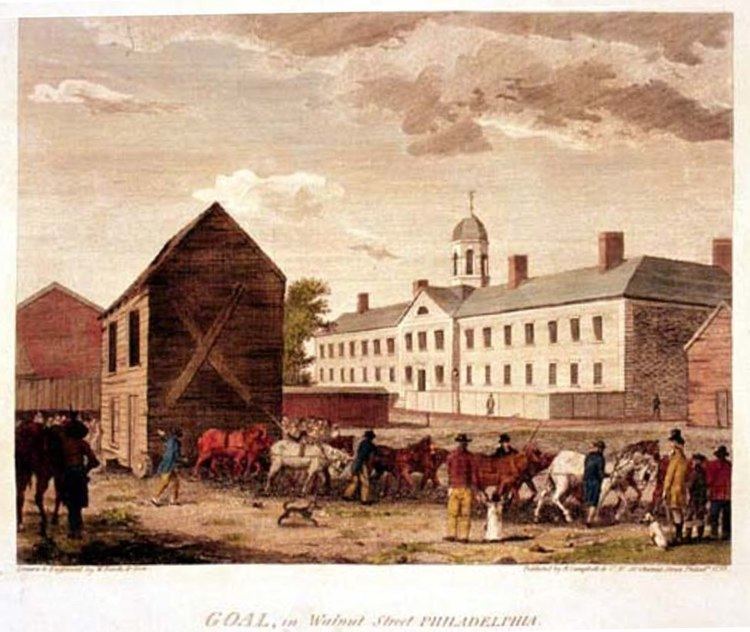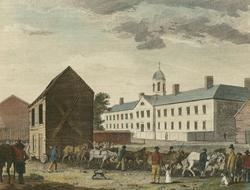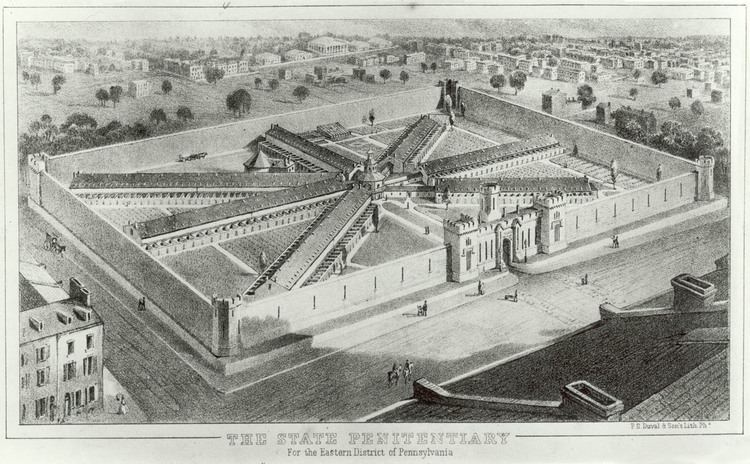 | ||
Walnut Street Jail, named after the Philadelphia, Pennsylvania street on which it was located, was the first prison built in the United States to use individual cells and work details.
Contents

Background

In 1773, in Philadelphia, Pennsylvania, a new jail was opened to receive the overcrowded prisoners of High Street Jail. It was located on Walnut Street on a lot bounded by Walnut Street, Sixth and Prune Street (now Locust), where it acquired the name Walnut Street Jail.
Architecture

The jail was designed to hold groups of inmates in large rooms. It was designed by Robert Smith. He was one of the most prominent architects in Philadelphia. The building was in the typical U-shape designed to hold large numbers of inmates. There was little regard for their physical well-being, nor were there any attempts to rehabilitate them. The prison was overcrowded and dirty, and inmates attacked each other regularly. Those who served their sentences came out of prison probably more inclined toward a criminal life than they were before their incarceration.

Some fifteen years later, an addition was made to the jail. They added a new cellblock and called it the "penitentiary house". Built in the courtyard of the existing structure, it included a series of small cells designed to hold individual prisoners. The cells and the corridors connecting them were designed to prevent prisoners from communicating with each other. Windows were high up (the cells had 9-foot-high (2.7 m) ceilings) and grated and louvered to prevent prisoners from looking onto the street. Each cell had a mattress, a water tap, and a privy pipe.
Success of the jail
The Walnut Street Jail was to be converted into a penitentiary in 1790. But because of political reasons (and the resistance of the jailer, John Reynolds) the transformation did not occur till 1795. As a penitentiary, solitary confinement was the goal, but such facilities were only available for about a third of those admitted. Other prisoners were made to sleep naked in a common room. Overcrowding undermined the goal of solitary confinement of serious offenders, and more than one inmate was placed in each cell. The isolation had a terrible psychological effect on inmates, and eventually inmates were given in-cell piecework on which they worked up to eight hours a day. Despite these difficulties, similar institutions were constructed in New York (Newgate in 1797) and New Jersey (Trenton in 1798).
Balloon flight
The first manned balloon flight in North America was made by Jean-Pierre Blanchard on January 9, 1793. He launched his balloon from the prison yard of the jail, in front of a crowd of spectators that included President George Washington, Vice-President John Adams, Thomas Jefferson, James Madison, and James Monroe. Blanchard crossed the Delaware River and safely landed in Deptford, New Jersey.
